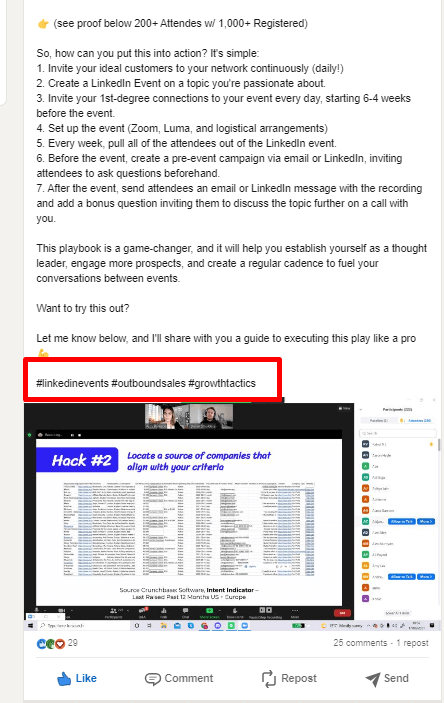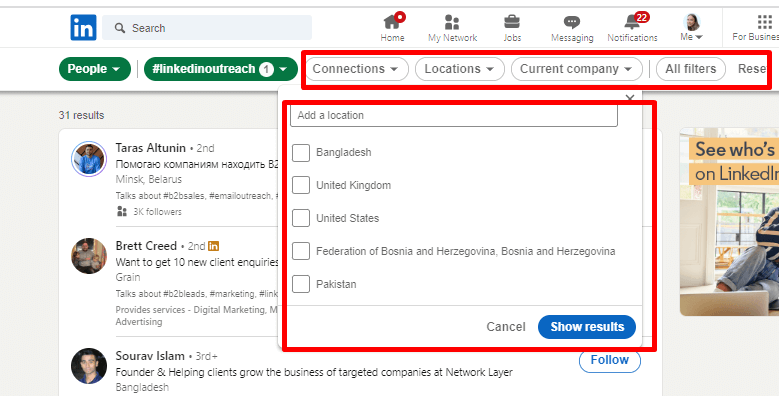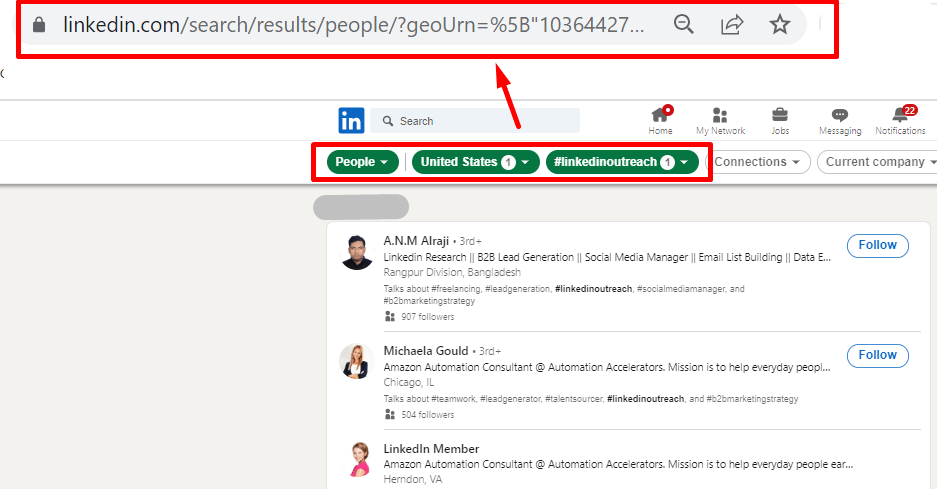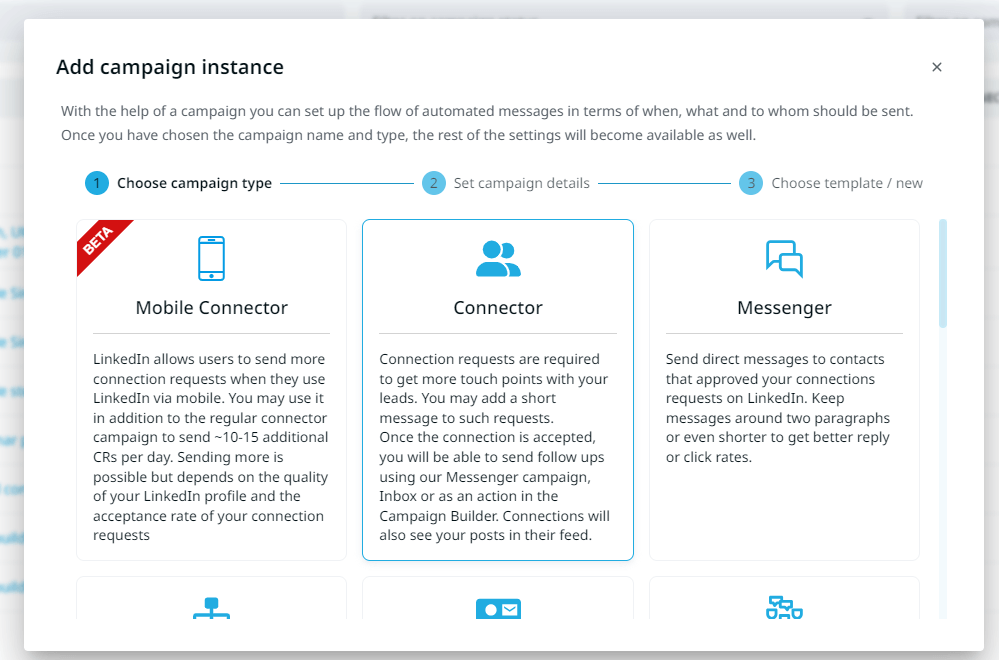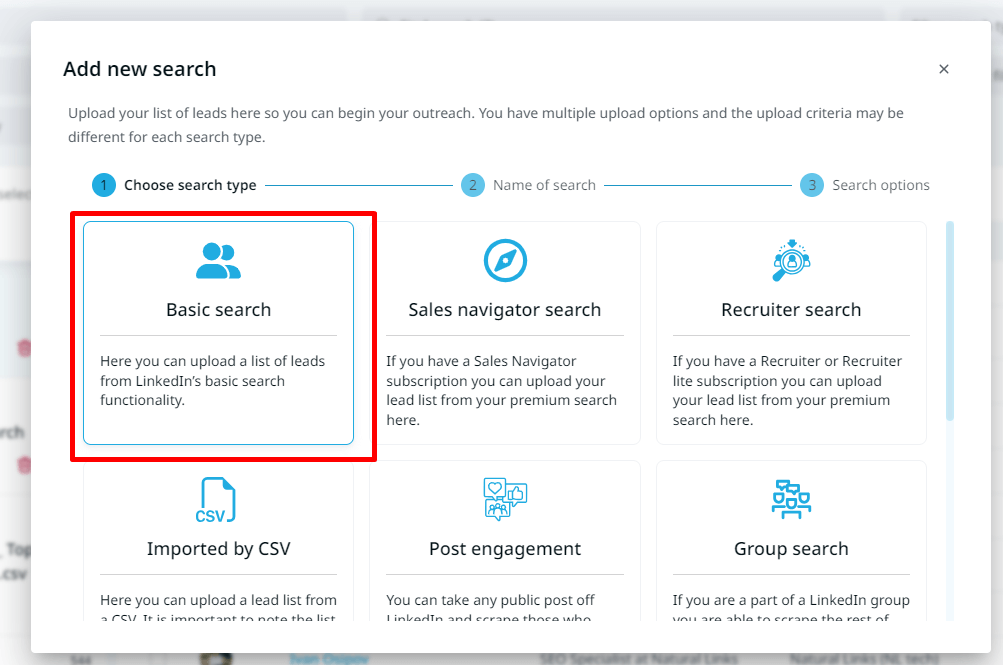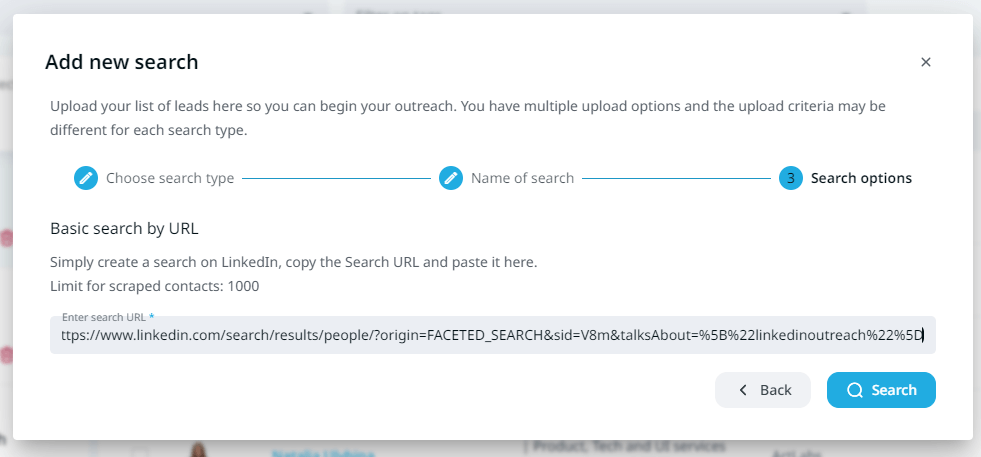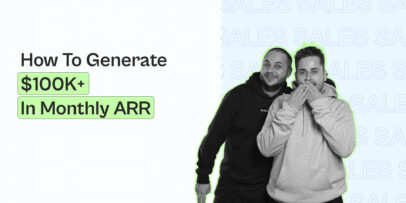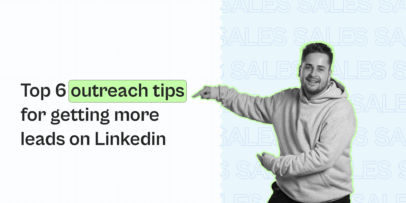Top 30 Linkedin Hashtags for Sales Teams
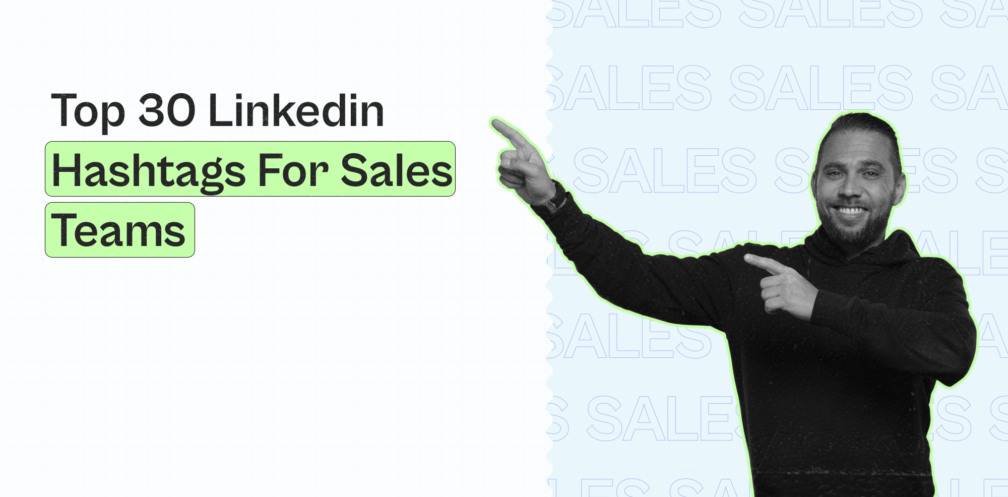
LinkedIn, the ultimate platform for professional networking and B2B interactions, offers an underestimated feature: hashtags!
Yep, those little # symbols can work wonders for sales teams. By sprinkling relevant hashtags into their LinkedIn posts, sales professionals can skyrocket their visibility, connect with their ideal audience, and spark meaningful conversations.
In this article, we’re taking a deep dive into the world of LinkedIn hashtags to show you how to make the most of them. We’ll unravel the mysteries behind LinkedIn hashtags, from adding them to your posts to browsing through hashtag feeds and even uncovering the hottest trending Linkedin hashtags in your industry.
And we’ve curated the top LinkedIn hashtags tailor-made for sales teams. Get ready to level up your team’s engagement and pave the way for extraordinary success.
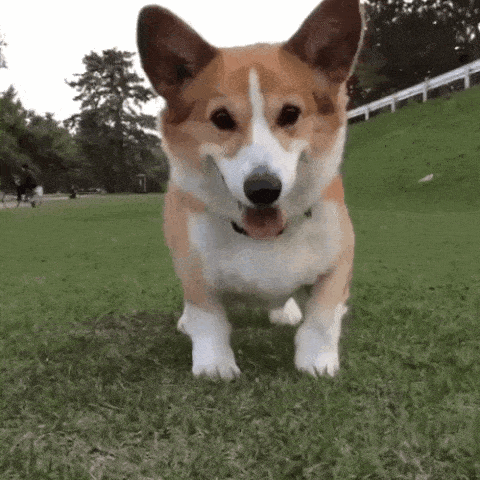
How LinkedIn Hashtags Work
LinkedIn hashtags work by categorizing and organizing content based on specific keywords or phrases preceded by the “#” symbol. When you include a hashtag in your LinkedIn post, it becomes clickable and allows users to discover other Linkedin posts that contain the same hashtag.
The purpose of using hashtags on LinkedIn is to increase the visibility of your posts and expand your reach to a broader audience. By adding relevant Linkedin hashtags to your content, you make it discoverable to LinkedIn users who follow or search for those hashtags.When you click on a hashtag in a post or use the LinkedIn search bar to search for a specific hashtag, you can explore a feed of posts that include that hashtag. This allows you to engage with discussions, share insights, and connect with other professionals who are interested in or working within the same industry or topic.
LinkedIn also offers a “Follow” feature for hashtags. By following a hashtag, you can see Linkedin posts containing that hashtag in your feed, even if you’re not connected with the individuals who posted them. This feature helps you stay updated on industry trends, join relevant conversations, and expand your network beyond your immediate connections.
Using hashtags effectively on LinkedIn involves choosing relevant and specific keywords or phrases that align with your content and target audience. It’s important to research popular and trending hashtags in your industry and incorporate them strategically into your posts to increase their visibility and engagement.

Top LinkedIn Hashtags for Sales Teams
- #Sales (25.5M followers): A general hashtag for all things sales-related, used by sales professionals to share insights, tips, and success stories.
- #SalesTips (3.2M followers): This hashtag is used to share practical sales tips, techniques, and strategies to help sales teams improve their performance.
- #SalesLeadership (1.2M followers): Focuses on leadership aspects of sales, including management, coaching, and developing effective sales teams.
- #SalesTraining (1.1M followers): Used for content related to sales training programs, methodologies, and best practices.
- #SalesStrategy (1M followers): Covers discussions on sales strategies, planning, and execution to drive revenue growth and achieve sales targets.
- #Salesforce (992.8K followers): Refers to the popular customer relationship management (CRM) platform, Salesforce, often used by sales teams.
- #B2BSales (945.3K followers): Targets business-to-business (B2B) sales professionals, discussing challenges, techniques, and strategies specific to B2B selling.
- #B2CSales (892.7K followers): Focuses on business-to-consumer (B2C) sales and provides insights into selling products or services directly to consumers.
- #SocialSelling (821.3K followers): Emphasizes the use of social media platforms for sales and networking purposes, sharing best practices and success stories.
- #ColdCalling (786.9K followers): Discusses cold calling techniques, tips, and experiences to help sales teams improve their prospecting efforts.
- #LeadGeneration (765.1K followers): Covers strategies and tactics for generating sales leads, including lead nurturing, lead scoring, and lead conversion.
- #ClosingDeals (745.6K followers): Focuses on the art and science of closing deals, sharing tips, techniques, and success stories related to closing sales.
- #CustomerRetention (732.4K followers): Explores methods for retaining existing customers, building loyalty, and enhancing customer satisfaction.
- #SalesProductivity (722.9K followers): Discusses tools, techniques, and habits that boost sales productivity, improve time management, and increase efficiency.
- #SalesMotivation (712.1K followers): Offers motivational content and inspirational quotes to keep sales teams motivated and focused on achieving their goals.
- #InboundSales (703.8K followers): Focuses on inbound sales methodologies, including lead qualification, lead nurturing, and closing deals through inbound marketing efforts.
- #OutboundSales (698.5K followers): Covers outbound sales techniques, including cold calling, prospecting, and reaching out to potential customers.
- #SalesEnablement (688.2K followers): Discusses strategies and tools to enable sales teams, including training, content, and technology for improving sales effectiveness.
- #SalesProcess (680.7K followers): Explores the different stages of the sales process, from prospecting to closing, and provides insights to optimize each step.
- #SalesPipeline (676.3K followers): Focuses on managing and optimizing the sales pipeline, including lead tracking, forecasting, and sales pipeline analytics.
- #CustomerSuccess (669.8K followers): Highlights the importance of customer success and shares best practices for building strong, long-term customer relationships.
- #SalesTech (661.2K followers): Discusses the latest sales technologies, tools, and software that can enhance sales effectiveness and efficiency.
- #SalesMetrics (653.9K followers): Explores key sales metrics and KPIs (Key Performance Indicators), helping sales teams measure and track their performance.
- #SalesCoaching (646.7K followers): Covers coaching and mentoring techniques for sales managers to develop the skills and performance of their sales teams.
- #SalesProspecting (641.8K followers): Focuses on techniques and strategies for finding and qualifying potential customers or leads.
- #NegotiationSkills (636.6K followers): Explores negotiation tactics, strategies, and best practices to improve sales negotiations and close deals successfully.
- #SalesSuccess (631.2K followers): Shares success stories, case studies, and insights into what it takes to succeed in sales.
- #SalesCareer (626.3K followers): Targets professionals interested in sales careers, discussing career development, job opportunities, and industry trends.
- #SalesBooks (621.8K followers): Recommends and discusses books on sales, sales techniques, and personal development for sales professionals.
- #SalesConference (616.5K followers): Highlights upcoming sales conferences, events, and webinars, providing networking opportunities and industry updates.
How to find the top trending hashtags in your industry
Finding the top trending hashtags in your industry is a great way to stay updated on the latest discussions and trends and engage with a broader audience. Here’s how you can discover those trending hashtags:
- LinkedIn Search. Go to LinkedIn and use the search bar at the top of the page to search for keywords related to your industry. For example, if you’re in the sales industry, you can search for terms like “OutboundSales,” “SalesProspecting” or “SalesProcess .”
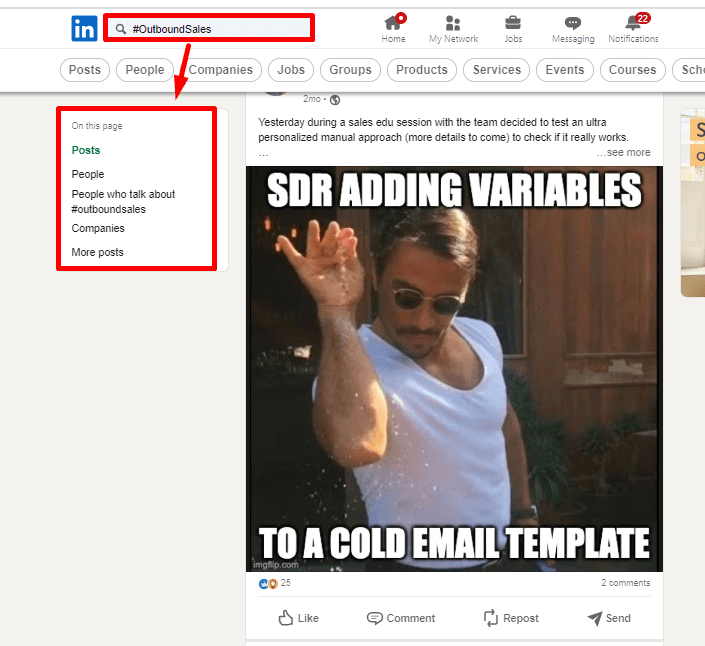
- Explore Content. Click on the “Content” tab in the search results to see the latest posts related to your industry. This will give you an idea of the trending topics and right LinkedIn hashtags being used by professionals in your field.

- Analyze Hashtags. Look for posts that have a significant number of likes, comments, and shares. These posts often indicate popular and engaging content. Pay attention to the niche hashtags used in these posts as they can be the top trending hashtags in your industry.
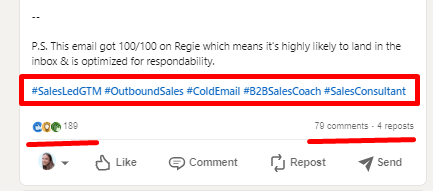
- Hashtag Suggestions. LinkedIn provides hashtag suggestions when you create a post. Start creating a new post by clicking on the “Start a post” button and begin typing a hashtag related to your industry. LinkedIn will automatically suggest relevant hashtags based on their popularity and usage.
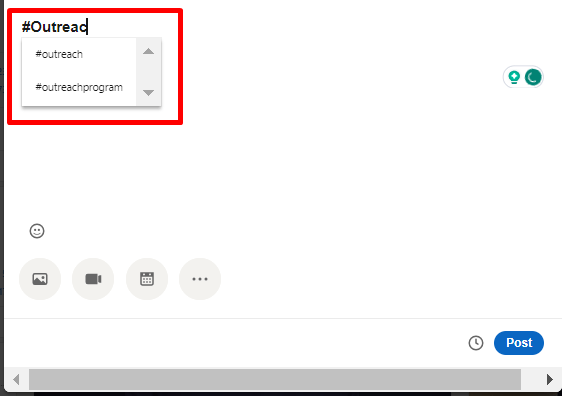
- Industry Influencers. Identify influencers or thought leaders in your industry on LinkedIn and examine their posts. Influencers often use trending hashtags to reach a broader audience and gain visibility. By following their posts, you can discover the most popular hashtags in your industry.
- LinkedIn Groups. Join relevant LinkedIn groups related to your industry. Explore the group discussions and analyze the hashtags used by members. Engage in conversations and keep an eye on the popular hashtags that gain traction within the group.
- External Tools. There are external tools and platforms that provide insights into LinkedIn hashtags, such as LinkedIn Analytics tools or social media monitoring tools. These tools can help you identify trending hashtags, track their popularity, and provide detailed analytics. You could use Hootsuite, Brand24, Keyhole, or any other tool.
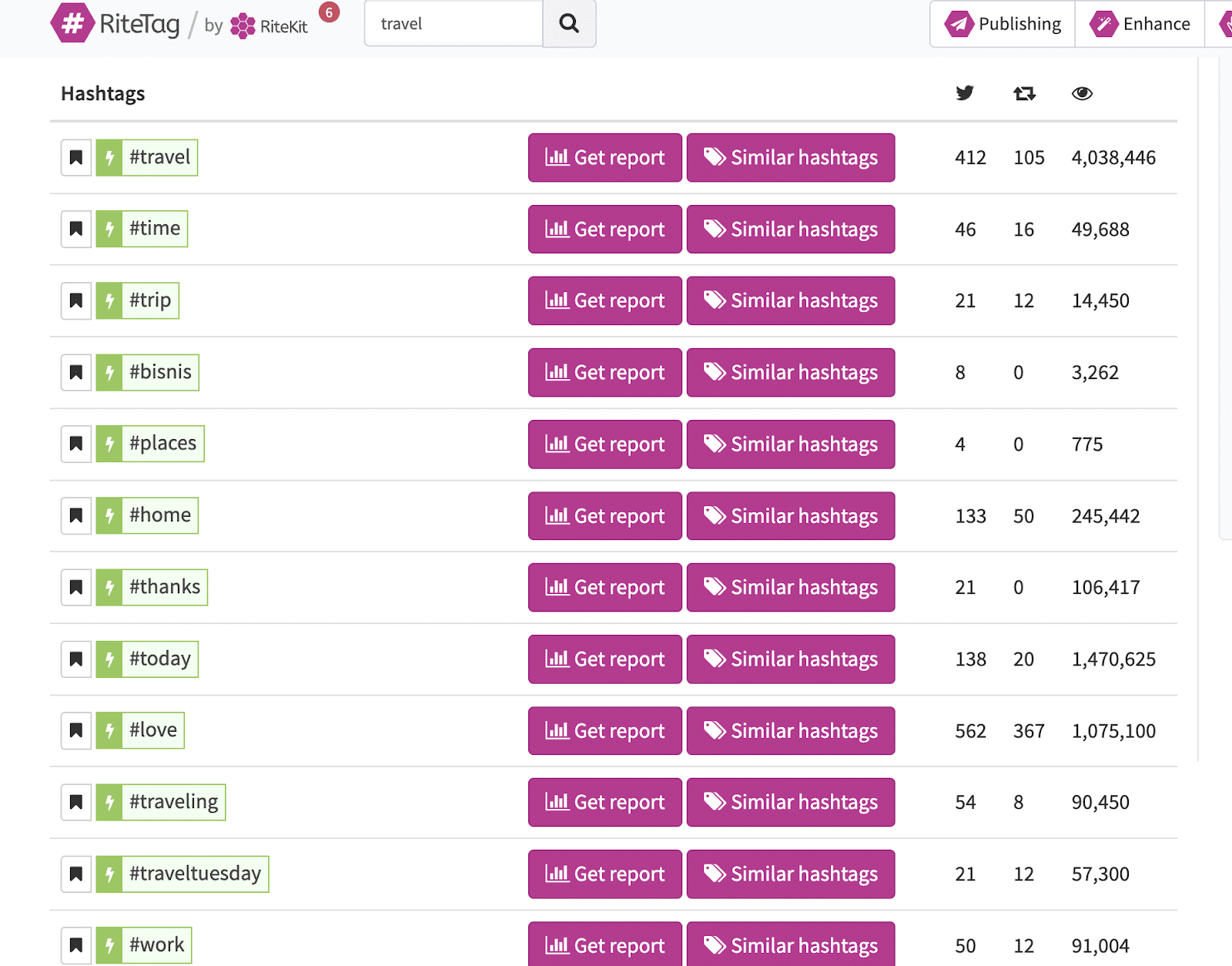
How to use Linkedin hashtags correctly to shape your content strategy
Using LinkedIn hashtag analysis can be beneficial in shaping your Linkedin content strategy. Here’s how you can leverage hashtag analysis to optimize your content on LinkedIn:
- Identifying and adding Relevant Hashtags. Analyze the trending hashtags in your industry or niche using the methods mentioned earlier. Look for hashtags that are popular, frequently used, and relevant to your target audience. These hashtags can help you reach a wider audience and increase visibility for your content.
- Analyze Engagement. Pay attention to the level of engagement (likes, comments, shares) on posts using specific hashtags. This indicates the level of interest and interaction around those topics. Focus on hashtags that generate higher engagement as they can help you create more compelling and relevant content.
- Content Inspiration. Explore posts and discussions using trending hashtags to gather insights and inspiration for your own content. Observe the type of content that resonates well with your target audience and aligns with your content strategy. Analyzing the content that performs well can help you understand the preferences and interests of your LinkedIn community.
- Content Planning. Incorporate relevant hashtags into your content planning process. Identify the hashtags that are most suitable for each piece of content based on their relevance and popularity. This can help you maximize the discoverability of your content by reaching the right audience.
- Hashtag Diversity. Don’t rely solely on one or a few hashtags. Use a mix of trending hashtags and industry-specific hashtags to diversify your content reach. This approach allows you to tap into different conversations and communities on LinkedIn and expand your content’s visibility.
- Monitor Performance. Track the performance of your content using LinkedIn analytics or third-party tools. Evaluate the engagement and reach of your posts using different hashtags. This analysis can help you identify which hashtags are driving better results and adjust your content strategy accordingly.

- Engage with Hashtag Communities. Actively participate in conversations and engage with LinkedIn communities using relevant hashtags. By contributing valuable insights and sharing your content within these communities, you can increase your visibility, build connections, and establish yourself as an authority in your industry.
- Stay Updated. Continuously monitor the changing trends and emerging hashtags in your industry. LinkedIn trends evolve over time, and it’s important to stay up-to-date with the latest hashtags to keep your content strategy relevant and engaging.
Best practices for using Linkedin hashtags
1. Use hashtags on your personal LinkedIn account
While LinkedIn profiles primarily focus on showcasing professional experience and skills, you can strategically use hashtags in your LinkedIn profile to enhance discoverability and reinforce your brand.

2. Use hashtags on your Linkedin business page
If you have a LinkedIn company page for your business, make sure to use relevant hashtags in the company description, updates, and job postings. This can improve the discoverability of your company page and attract followers who are interested in those specific topics or industries.
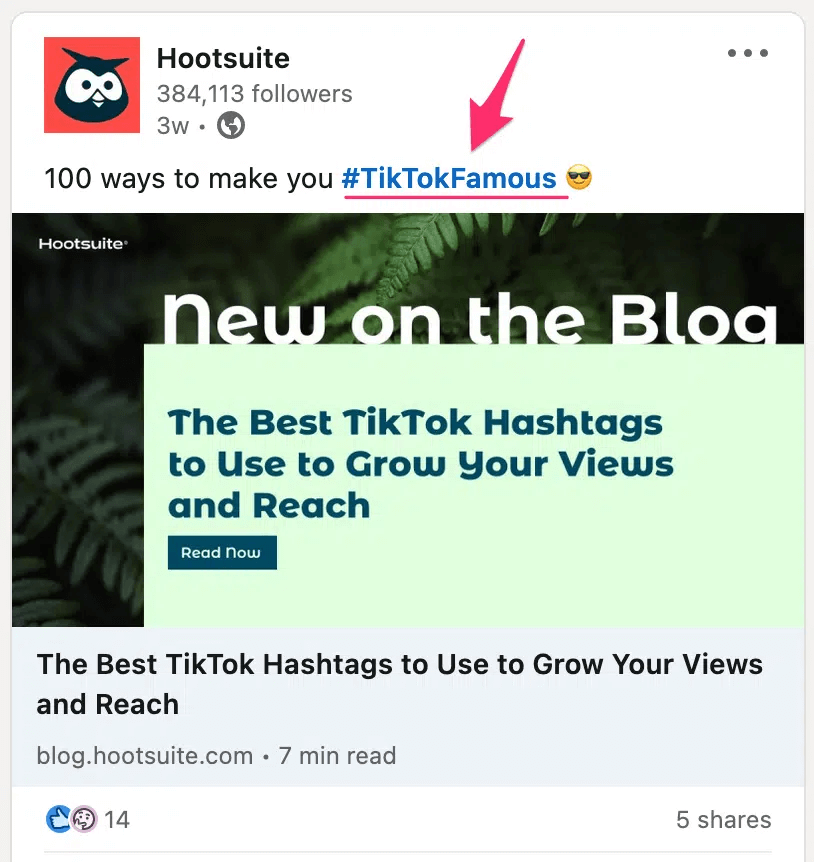
3. Use hashtags on your LinkedIn status updates or Linkedin articles
On LinkedIn, you can share two kinds of “hashtaggable” content:
- Linkedin Posts: These can be text-based or include photos, videos, documents, or other media.
- Linkedin Articles: These are like mini-blogs and are ideal for longer pieces. They are commonly used on personal profiles to showcase thought leadership.
To add a hashtag to a LinkedIn post, follow these steps:
- Go to the top of LinkedIn’s homepage and click on “Start a post.”
- Type your post content.
- In LinkedIn’s post editor simply type the “#” symbol to add the hashtag.
- As you type your hashtag, LinkedIn will provide you with suggested hashtags.
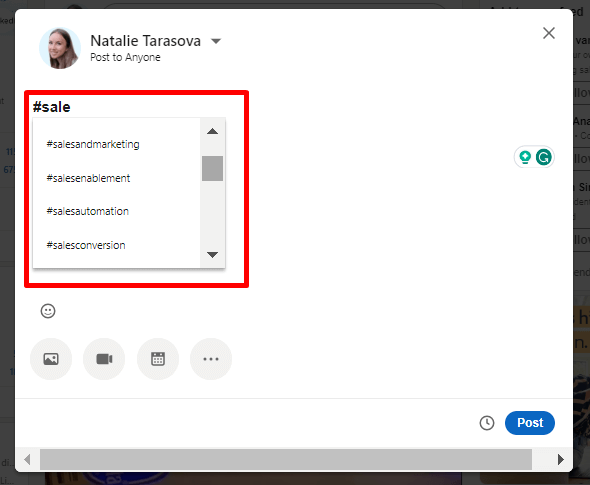
To add a hashtag to a LinkedIn article, follow these steps:
- Go to the LinkedIn homepage.
- Click on “Write article.”
- In your article, include hashtags as regular text.
- Once you publish the article, the hashtags will automatically become clickable.
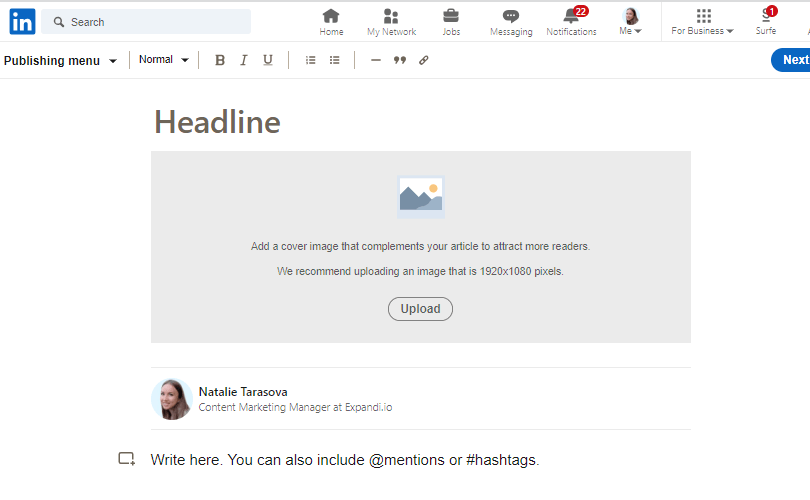
Follow these tips to get the most out of hashtags for boosting your content on Linkedin:
- Relevant and Targeted Hashtags. Choose hashtags that are relevant to the content of your status update and your target audience. Research popular and industry-specific hashtags that align with your post’s topic or theme. For example, if you’re sharing an article on digital marketing, you could include hashtags like #DigitalMarketing, #MarketingStrategy, or #SocialMedia.
- Use general and niche hashtags in each post. To maximize the visibility of your post to the right audience, it’s recommended to select 1 or 2 general hashtags and 1 or 2 highly specific hashtags. Why? This strategy increases your chances of reaching two important groups: those interested in your overall topic and those who share similar interests.
- Limit the Number of Hashtags. LinkedIn allows you to include multiple hashtags in your status update. How many hashtags should you include? The general recommendation is to use a moderate number of hashtags (around 3-5) to maintain readability and avoid overwhelming your audience. If you include 10 hashtags, your post will remain visible under all 10 hashtags. LinkedIn’s recommendation likely focuses on aesthetics and aims to prevent users from excessively using 100 hashtags in each post, which would clutter up their home feeds. Focus on quality over quantity by selecting the most relevant and effective hashtags.
- Placement in the Status Update. You can include hashtags within the body of your status update or at the end. Experiment with both approaches to see which works best for your content and engagement. For instance, you could integrate hashtags naturally within the text or add them at the end of your update as a separate line.
- Highlighting Keywords. Hashtags can be used to highlight keywords or key phrases in your status update. This can help draw attention to specific topics and make your content more discoverable. For example, if you’re sharing a post about leadership skills, you can use hashtags like #LeadershipTips, #ManagementSkills, or #ProfessionalDevelopment.
- Personalized Hashtags. Consider creating personalized/branded hashtags that align with your brand or campaign. These unique own hashtags can help you track engagement and conversations specific to your content. For example, if you’re promoting a webinar, you could create a hashtag like #YourWebinarName to encourage attendees and participants to use it when discussing the event.
- Capitalize each word. Make sure you capitalize every single word when you’re using hashtags. If the hashtag has multiple words, it’s all good to capitalize the first letter of each word. So instead of typing #socialforgood, go ahead and type #SocialForGood.Capitalizing words helps everyone read them better, but it’s especially important for accessibility. You see, peeps who are blind or have visual impairments use screen readers to read stuff on the web. When it comes to hashtags, those screen readers need capitalization to figure out each word and read it out loud correctly.
- Use Hashtag Generator. Creating right hashtags for every single Linkedin post can be an arduous task. Whenever you compose a post using, for instance, Hootsuite’s Hashtag Generator, the AI technology will suggest a personalized set of hashtags based on your draft. This tool analyzes both your caption and uploaded images to provide you with the most relevant tags.
The chosen hashtags will be automatically added to your post. You can proceed to publish it immediately or schedule it for later.
How to Use Hashtags to find the right Audience for Linkedin outreach using Expandi
Hashtag helps people find and engage in good conversations easily. You can find and follow professionals who want to discuss similar topics through hashtags. Tell me the type of person who would like to get into communication in the marketing world. If you search #Marketing you will get a feed of other marketers’ posts. It’s possible for people to start their conversation with something thought-provoking with this hashtag. It helps you find other professionals in your field and keeps your knowledge updated.LinkedIn hashtags can also help you to find the right people for the LinkedIn outreach. Let’s share two use cases on how to do it:
1. Connect with “People who talk about #{hashtag}
For starters, you should decide which LinkedIn hashtag strategy to choose. You can choose location-based hashtags, top hashtags, or niche hashtags to find targeted LinkedIn members who use these hashtags in their profile’s description.
- Go to LinkedIn and add hashtags to the search field.
- Click on “People who talk about #{hashtags related to a particular business industry}” and then click on “See more.”
- You can also add additional filers if need be. Don’t forget to click Show results
- As a result, you will receive a list of contacts who use LinkedIn hashtags and meet other requirements of your ICP and buyer persona.
- Copy the Linkedin search results URL
- Open Expandi and go to the Campaigns section on the sidebar menu on Expandi, and click on the button Add Campaign
- Choose the campaign you want to create from the list
- Design your message and follow-ups, set time delays between follow-ups, and click Apply to save the changes.
- The last step would be to create a search and assign the leads to the campaign, so it could start the outreach. Switch to the People tab.
- Click Add new search.
- Then chose Basic Search from the list.
- add the LinkedIn search URL that you copied earlier from LinkedIn to the Expandi field and click Search.
- When the contacts from the LinkedIn search results are scraped, you should select all the contacts and assign them to the campaign that you created earlier.
2. Connect with people who liked or commented on posts with trending hashtags on LinkedIn
You can also outreach people who engaged with Linkedin posts that include popular LinkedIn hashtags.
- Go to LinkedIn and add the most popular LinkedIn hashtags to the search field
- Find the most engaging posts
- Scrape these people using Expandi (check this tutorial to learn how to do it) and Create a hyper-personalized outreach campaign, that allows you to mention the content of the LinkedIn post they engaged.
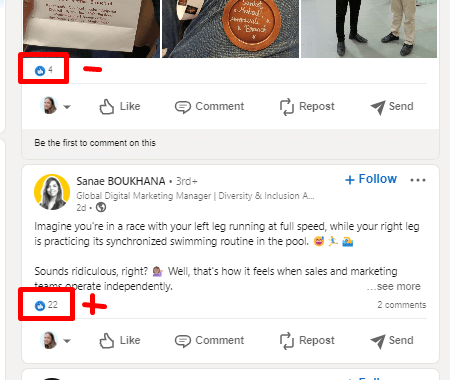
Conclusion
LinkedIn hashtags have emerged as a powerful tool for sales teams to enhance their brand, engage customers, and refine their audience. By leveraging the top 30 hashtags tailored for sales professionals, teams can unlock new opportunities for success. The use of hashtags on LinkedIn works by categorizing and organizing content based on specific keywords or phrases, allowing users to discover related posts and join relevant conversations. Through strategic hashtag selection, sales teams can increase their visibility, expand their reach, and connect with their target audience.
You’ve made it all the way down here, take the final step
